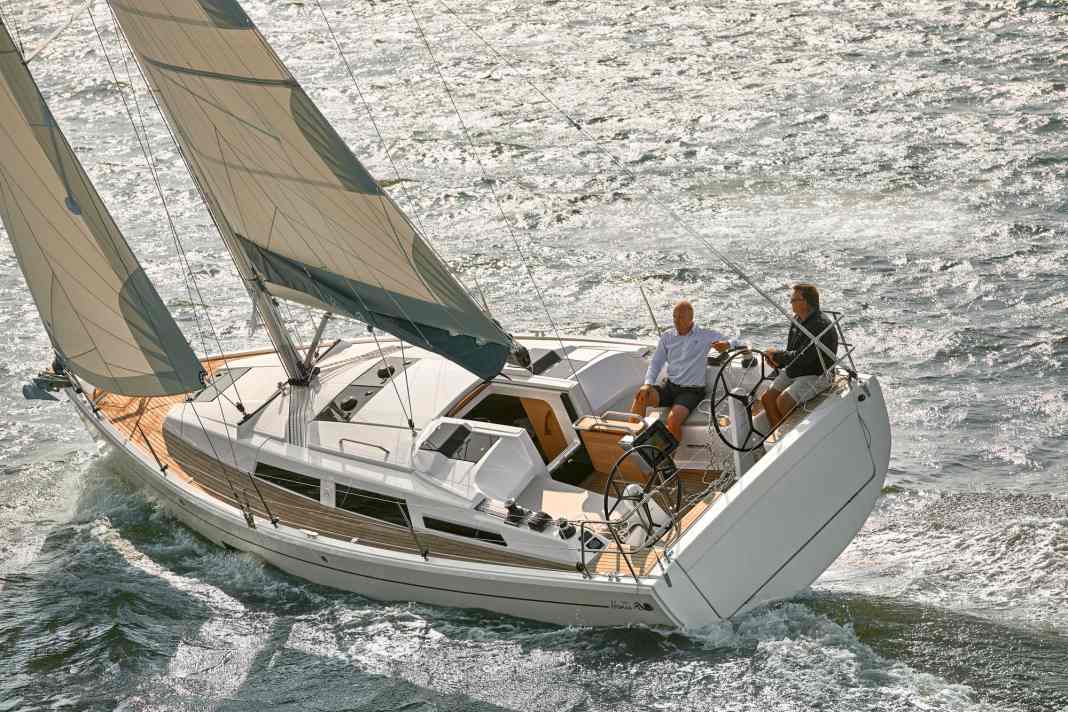





The ten-metre yacht class is and remains highly attractive, even if many production yards seek and find salvation and profit in larger units up to over 60 feet. When well executed, 34 feet means a boat that is seaworthy, sails well, can cope with wind and waves and is still easy to handle with a small crew or single-handed. The typical ten-metre-long cruiser offers a separate forward and aft cabin; two compartments in the stern are available as an option. There is also a saloon for at least four people, a navigation corner, a wet room with shower and a veritable galley.
The whole thing with headroom, sufficiently large berths, reasonably motorised and equipped with tank and battery capacities that mean a certain degree of self-sufficiency at sea and at anchor. What's more, a boat of this calibre should be available to a wider range of customers.
The customer has a good choice: Bavaria, Beneteau, Dufour and Jeanneau, but also Hallberg-Rassy offer ten metre long yachts. And Hanseyachts too.
Competition from the Hanseatic League 348
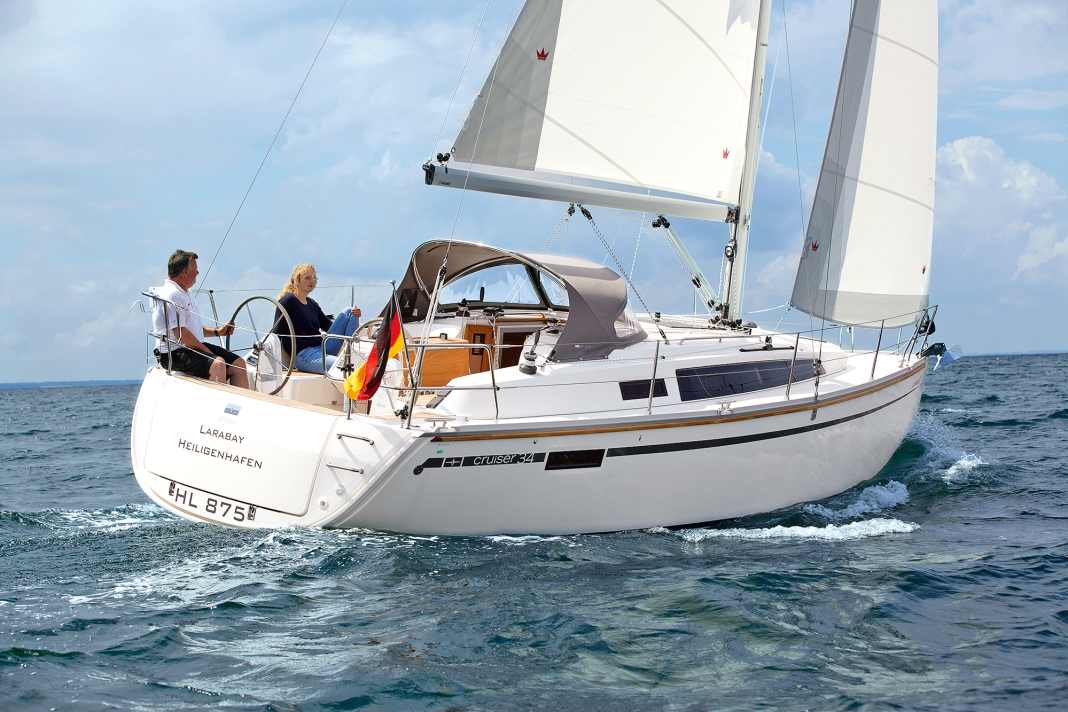




The model is based on the Hanse 345, a proven design by Judel/Vrolijk. One of the objectives was to improve the performance of the model in the lower wind range, where boats with a self-tacking jib are naturally weak. The sail area was therefore increased by four square metres. Other technical sailing measures include an eight-centimetre lower L-keel instead of a T-keel, which should be more effective in this dimension and also catch less flotsam or seaweed.
Longer mast, more fabric
Hanseyachts continues to rely on the self-tacking jib. In the past, genoa rails were still offered and the aluminium inserts in the deck were generally laminated in without the extra for retrofitting, but the shipyard has now dispensed with this measure. The "take-up rate of the genoa option was close to zero," says Pascal Kuhn, Product Manager Sailing Yachts. His colleague Karl Dehler, Project Manager Sailing Yachts: "Instead of the 105 per cent genoa, we offer a kind of code zero on the roller. It has a surface area of 49 square metres and is a real turbo for light winds when you can't go really high anyway." In fact, the special sail called "Crossover" at Hanse is about twice the size of the self-tacking jib. Of course, the Code Zero is an extra; with furling system, halyard, sheets and blocks, the Elvstrøm product costs around 5000 euros. A conventional gennaker as a light wind turbo comes on board with peripherals for around 800 euros less.
Speed in light winds is a nice thing, but for most customers looking for a pure cruising boat it is only a secondary virtue. In this respect, the conditions for the test were ideal: Between 12 and 14 knots of wind fanned out across the Greifswalder Bodden. 4 Beaufort, sailing from the pleasant side, fast, still dry, easy to handle.
Hanse 348 runs on track and starts well
The Hanse 348 steers excellently. The Jefa twin-wheel system with continuous cable pull is still direct enough at one and three-quarter turns, and the arm stroke of the average North European is sufficient for the steering movements required on the cross when sitting sideways. However, as is typical for the class, the double backstay is a bit of a hindrance to the helmsman. The optional GRP wheels from Carbonautica (although pleasant to hold) have a lower axle than those made of stainless steel, which takes up more space.
The boat easily finds its track and the speed is easy to retrieve. 6.3 knots can be achieved in combination with a low tacking angle in smooth water. It also helps that the Elvstrøm sails are not only new, but come from a higher shelf. Instead of the standard horizontally laid Dacron fabric, triradially orientated FCL with a clean profile is used on the Seldén rig, which can be trimmed to a certain extent, with two pairs of swept-back spreaders. The stability is obvious. Large forced lean angles in pushers do not cause any loss of control on the single rudder. The Hanse confidently takes the short Bodden waves.
Operation from the wheels
In typical Hanseatic fashion, the helmsman can operate the sheets and halyards from the main winches installed just in front of the wheels. The excess line material disappears into two stowage boxes - subject to minor tidying up. The forward cockpit and companionway remain free of controls, as the 4:1 mainsheet is also out of the way. It works without travellers on the coachroof and is led fore and aft on both sides. If a fellow sailor wants to operate the sheets, it is a good idea to route them to the forward winches via the aft winches, if this is ticked on the extra list.
The chart plotter is mounted under the optional cockpit table (1200 euros) and is easy to reach and read. However, the compass underneath can only be viewed there for checking purposes. The table with teak flaps on both sides also has its function in the harbour and as a support at sea. However, the prospective owner should consider whether it will make the cockpit too cramped before ordering. The cockpit is closed with a bathing hatch, which is also optional. Measuring 2.20 by 0.70 metres, this is a substantial and sensible expense for more comfort at anchor and in the harbour.
A 21 hp Yanmar is used on the Hanse 348, 29 hp can also be ordered. A good 6 knots cruising speed at 80 per cent rpm should be enough, and the noise level remains within reasonable limits. The boat manoeuvres inconspicuously, pulling to port only slightly less willingly when reversing. The large fuel tank with a volume of 160 litres is pleasing. With an assumed consumption of less than 3 litres, refuelling would only be necessary after more than 50 hours of continuous sailing.
The 230 litre water tank also contributes to a certain degree of self-sufficiency. However, the service batteries (AGM) only have 160 ampere hours as standard, which is a little low in view of a nominal usability of only 50 per cent. Speaking of scarcity: the space in the cockpit is quite limited in the version with two cabins in the rear - the market demands this, but it is not practical. It gets cramped on board with six people. In addition, the two aft cabins also mean a smaller bathroom.
The expansion was a success overall
The test boat was equipped with a stern cabin on the starboard side and walk-in storage space on the port side. The cabin, which is around two metres long and on average one and a half metres wide, can be accessed through the bathroom via a small door or from above through the flat port locker above. The bathroom is almost princely. The three areas - toilet, washbasin and shower - are well separated from each other in a row. The single aft cabin has a one-and-a-half metre wide berth and a room height of 1.81 metres. Cupboard space, deck hatch, reading lights with USB connection: the level of comfort is decent.
Likewise in the foredeck. The only noticeable thing there is a certain emptiness: Instead of overhead lockers, there are only two short shelves above the berths, which are fitted with flat coamings and are therefore difficult to use. An example of saving costs, as project manager Kuhn explains: "The Hanse 348 is just as elaborate and complex as the next largest, but has to cost significantly less. We have to make up for that somewhere."
And there are also various options for the smaller boats such as the 348, a concept with which the shipyard became big and forced the competition to react. There is a choice of five coloured gelcoats, seven trim strips, various other paint colours, natural and eight types of artificial teak as well as different upholstery and carpets. And then there are four floors, two worktops and five veneers for the furniture plus the option of grey wall unit fronts - a rare variety that can turn any boat into something unique if desired.
Minor downsides in the interior: fuses instead of automatic machines are inconvenient. The wall units in the galley cannot be fully opened at the same time, and the cross ventilation in the saloon and galley is a little poor.
Good classification in the size segment
All in all, the Hanse 348 is proof that a new boat does not have to reinvent the sandwich: The modifications compared to the 345 have done well, the tried and tested have remained on board, new things have been added, all good. However: The choice in the ten-metre class remains difficult. The competition from Bavaria and even more so from the French shipyards is fierce. If you can spend twice as much, take a look at the Hallberg-Rassy 340. If you want something sportier, you will find an even more extensive range with equivalents from Dehler, Diva, Elan, Grand Soleil, Italia and J Boats.
In this respect: The size class is becoming ever larger, more diverse and more attractive. And the Hanse 348 plays an important role in this.
Boat from the construction kit
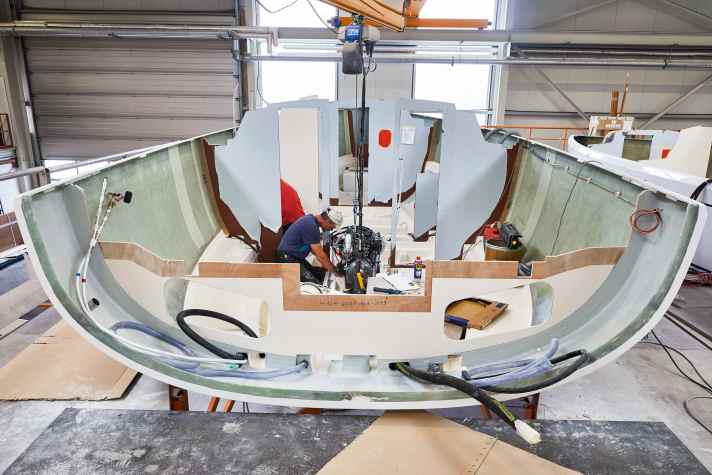
Most of the units, such as the 348, are laminated by the wholly-owned Hanse subsidiary TTS in Goleniow, Poland. Furniture production and assembly line finishing take place in Greifswald. The Hanse Group includes the sailing yacht brands Hanse, Dehler, Moody and Varianta, the motorboat lines Fjord and Sealine and now the French catamaran manufacturer Privilège. In the 2016/17 financial year, the group generated a turnover of 129 million euros and sold 589 boats. 75 per cent of the listed company is owned by the Aurelius Group.
The measured values for testing the Hanse 348
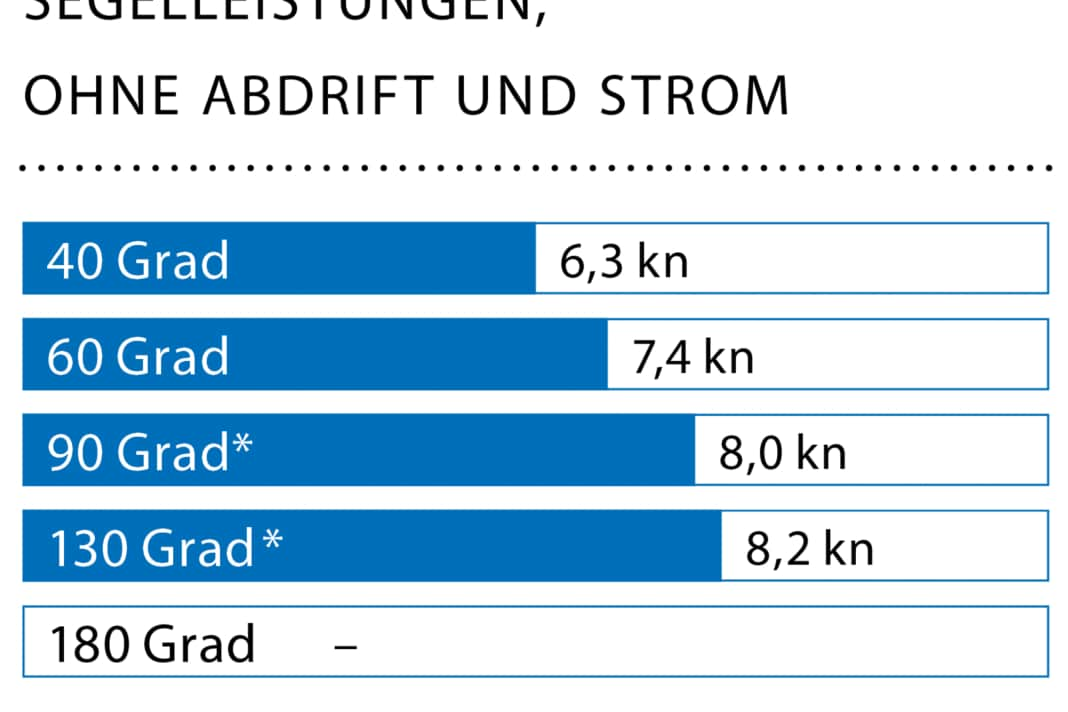



The Hanse 348 in detail
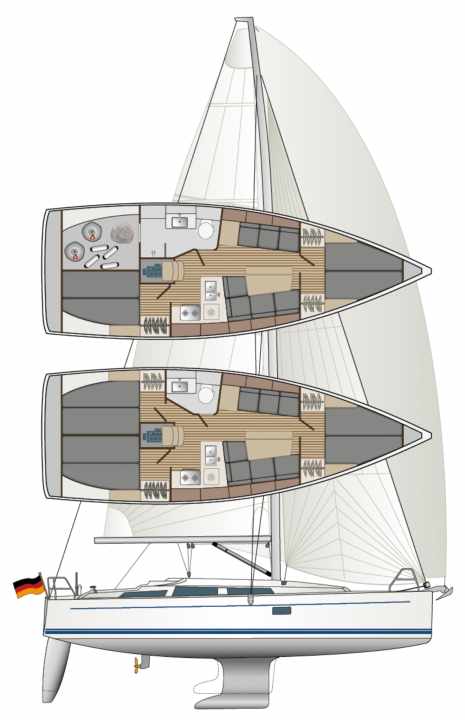
Technical data of the Hanse 348
- Designer: Judel/Vrolijk
- CE design category: B
- Torso length: 9,99 m
- Waterline length: 9,55 m
- Width: 3,55 m
- Draught/alternative: 1,95/1,55 m
- Weight (standard keel): 6,3 t
- Ballast/proportion: 2,1 t/33 %
- Mainsail: 35,5 m2
- Self-tacking jib: 23,0 m2
- machine (Yanmar): 15 kW/21 hp
Hull and deck construction
Hull above water balsa sandwich, underneath full laminate, partly vinylester resin. Deck Balsa sandwich
Price and shipyard
- Base price ex shipyard: 189.900 €
- Guarantee/against osmosis: 2/2 years
As of 03/2024, how the prices shown are defined can be found here!
YACHT review of the Hanse 348
The Hanse 348 is a boat that sails well and pleasantly, is suitable for small crews and is comfortable at a reasonable price. However, the basic equipment is quite limited and requires some reordering
Design and concept
- + Proven design improved
- + Many options
Sailing performance and trim
- + High potential
- + Pleasant steering behaviour
- + Well-functioning deck layout
Living and finishing quality
- + Plenty of cupboard space
- + Separate shower (two cubicles)
- - Small shelf in the compartments
- - Little deck stowage space (three cabins)
Equipment and technology
- + Large tank volume
- - Fusible links
The article first appeared in YACHT 15/2018 and has been updated for the online version.

